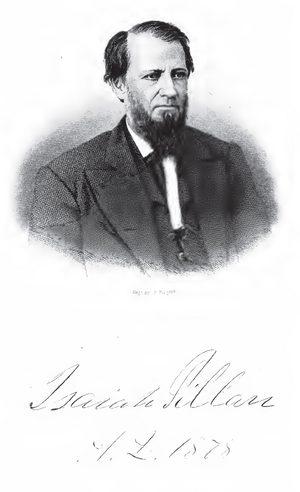Isaiah Pillars facts for kids
Quick facts for kids
Isaiah Pillars
|
|
|---|---|
 |
|
| 14th Ohio Attorney General | |
| In office January 14, 1878 – January 12, 1880 |
|
| Governor | Richard M. Bishop |
| Preceded by | John Little |
| Succeeded by | George K. Nash |
| Member of the Ohio House of Representatives from the Allen County district |
|
| In office January 1, 1872 – January 4, 1874 |
|
| Preceded by | William Armstrong |
| Succeeded by | Thomas M. Robb |
| Personal details | |
| Born | March 17, 1833 Jefferson County, Ohio |
| Died | September 13, 1895 (aged 62) Lima, Ohio |
| Resting place | Old Lima Cemetery |
| Political party | Democratic |
| Spouse | Susan Fickle |
| Children | four |
| Alma mater | Heidelberg College |
| Military service | |
| Allegiance | United States |
| Branch/service | Union Army |
| Rank | Colonel |
| Commands | Camp Lima |
Isaiah Pillars (born March 17, 1833, died September 13, 1895) was an important lawyer and politician from Ohio. He served in the Ohio House of Representatives and later became the Ohio Attorney General.
Contents
The Life of Isaiah Pillars
Isaiah Pillars was born on March 17, 1833, in Jefferson County, Ohio. He spent his early years in Carroll County, Ohio and then moved to Risden, which is now Fostoria, Ohio. Sadly, his mother passed away when he was only eight years old.
When he was sixteen, Isaiah began working as a teacher. He also studied at the Seneca County Academy and Heidelberg College in Tiffin, Ohio. He learned about law by working in his brother James Pillars' office.
Starting a Law Career
At the age of 21, Isaiah Pillars became a lawyer. He started his own law practice in Lima, Ohio, in 1855.
During the American Civil War, in 1862, he was put in charge of Camp Lima by Ohio's Governor David Tod. He held the rank of Colonel and helped organize three important military groups: the 99th Ohio Infantry, the 118th Ohio Infantry, and the 81st Ohio Infantry.
Public Service in Ohio
In 1866, Pillars was elected as the Prosecuting Attorney for Allen County. This job meant he was the chief lawyer for the government in that area.
In 1871, he was elected to the Ohio House of Representatives as a Democrat. He served in the state legislature from 1872 to 1873. During his time there, he strongly disagreed with a tax that would help pay for building railroads. He was later proven right when the Ohio Supreme Court decided that this tax was against the law.
Views on Justice
Isaiah Pillars also wrote a special report that argued against the death penalty. He believed it was an old way of thinking about punishment. Here are some of his main points:
- He thought that using death as a punishment was like seeking revenge.
- He felt that society could be safe without needing to execute criminals.
- He believed that the death penalty did not stop others from committing crimes.
- He thought it made society less caring and could even lead to more crime.
- He argued that if someone was executed, they could never change for the better.
- He worried that innocent people could be put to death by mistake.
- He suggested that sending criminals to prison for life would make sure more criminals were caught and punished. This, he believed, would reduce crime more effectively.
Ohio Attorney General
In 1877, Pillars was elected as the Ohio Attorney General. He won against Republican George K. Nash. However, when he ran for re-election in 1879, he lost to Nash.
Interestingly, Isaiah Pillars was not always a Democrat. He had been a Republican until 1864, when he decided to join the Democratic Party.
Family and Beliefs
Isaiah Pillars married Susan Fickle in 1866, or possibly 1856. She passed away in 1870. They had four children: two sons and two daughters. One of their daughters died when she was very young.
Pillars was a follower of the teachings of Emanuel Swedenborg. He even wrote a short book about Swedenborg's life and ideas.
Isaiah Pillars passed away in Lima, Ohio, on September 13, 1895.

